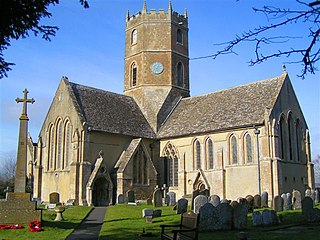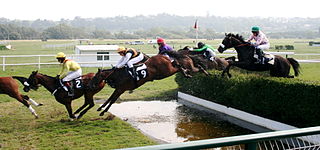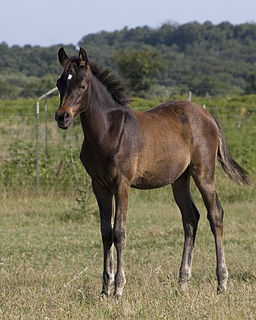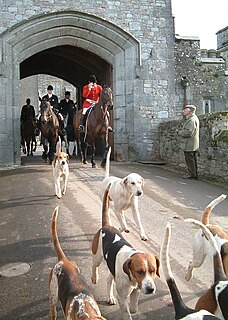
Arkle was an Irish Thoroughbred racehorse. A bay gelding by Archive out of Bright Cherry, he was the grandson of the unbeaten flat racehorse and prepotent sire Nearco. Arkle was born at Ballymacoll Stud, County Meath, by Mrs Mary Alison Baker of Malahow House, near Naul, County Dublin. He was named after the mountain Arkle in Sutherland, Scotland that bordered the Duchess of Westminster’s Sutherland estate. Owned by Anne Grosvenor, Duchess of Westminster, he was trained by Tom Dreaper at Greenogue, Kilsallaghan in County Meath, Ireland, and ridden during his steeplechasing career by Pat Taaffe.
In horse racing in the United Kingdom, France and the Republic of Ireland, National Hunt racing requires horses to jump fences and ditches. National Hunt racing in the UK is informally known as "jumps" and is divided into two major distinct branches: hurdles and steeplechases. Alongside these there are "bumpers", which are National Hunt flat races. In a hurdles race, the horses jump over obstacles called hurdles; in a steeplechase the horses jump over a variety of obstacles that can include plain fences, water jump or an open ditch. In the UK the biggest National Hunt events of the year are generally considered to be the Grand National at Aintree and the Cheltenham Gold Cup.

The North Wessex Downs Area of Outstanding Natural Beauty (AONB) is located in the English counties of Berkshire, Hampshire, Oxfordshire and Wiltshire. The name North Wessex Downs is not a traditional one, the area covered being better known by various overlapping local names, including the Berkshire Downs, the North Hampshire Downs, the White Horse Hills, the Lambourn Downs, the Marlborough Downs, the Vale of Pewsey and Savernake Forest.

Uffington is a village and civil parish in Oxfordshire, about 4 miles (6.4 km) south of Faringdon and 6 miles (10 km) west of Wantage. The 2011 Census recorded the parish's population as 783.

Timeform is a sports data and content provider located in Halifax, West Yorkshire, England founded in 1948 to provide information to fans, bettors, and others involved in the horse racing industry. The company was purchased by the sports betting exchange Betfair in December 2006. Since 2 February 2016, it has been owned by Paddy Power Betfair.

Flyingbolt was a famous racehorse. Officially he is the second best National Hunt racehorse of all time, after Arkle. A comparison of their merits is probably best illustrated by the Official Steeplechase Handicapper, who at the end of the 1965-1966 season rated Arkle the superior by only 1 lb (0.5 kg). Timeform, the highly respected racing publication, had a difference of 2 lbs between them. As a hurdler, Flyingbolt was the best Tom Dreaper ever trained. His wins included the Gloucestershire Hurdle at Cheltenham and the Scalp Hurdle at Leopardstown. He also finished third in the Champion Hurdle at Cheltenham. Flyingbolt and Arkle never raced against one another, mainly because they were trained by the same man and he preferred to keep them apart.
Crisp was a champion steeplechase horse. He was a bay Thoroughbred gelding that was foaled in 1963 in Australia. In his native country, he won many important jumping races, particularly two-milers, including the Hiskens Steeplechase in 1969 and 1970. So well did he jump, he was nicknamed "The Black Kangaroo". However, Crisp is probably best remembered for his epic contest with Red Rum in the 1973 Grand National in England.
The Future Champion Novices' Chase is a Grade 2 National Hunt steeplechase in Great Britain which is open to horses aged five years or older. It is run at Ayr, Scotland, over a distance of about 2 miles, 4 furlongs and 110 yards, and during its running there are seventeen fences to be jumped. The race is for novice chasers, and it is scheduled to take place each year in April.
Cool Dawn was a National Hunt chaser of the 1990s who went from winning minor Point-to-Point races to winning the 1998 Cheltenham Gold Cup, the Blue Riband of National Hunt Racing.
Morley Street (1984-–2009) was an Irish racehorse. He was a specialist hurdler but also won steeplechases and races on the flat. In a racing career which lasted from November 1988 until December 1995, he ran forty-five times and won twenty races including the Champion Hurdle in 1991 and the Aintree Hurdle on four successive occasions. He won the title of American Champion Steeplechase Horse on two occasions, as a result of back-to-back wins in the Breeders' Cup Steeplechase.
Mr Mulligan was an Irish-bred, British-trained Thoroughbred racehorse. He was a specialist steeplechaser who ran twelve times and won seven races under National Hunt rules. After mixed success in Point-to-point, Mr Mulligan rose to prominence by winning five successive races of increasing importance in the 1995/1996 National Hunt season. He became known for his front-running style and occasionally erratic jumping. In the following year he appeared to have lost his form before recording an upset win over a strong field in the 1997 Cheltenham Gold Cup. He was retired after being injured in training in 1998. Eighteen months later he died after being injured in a paddock accident.
Captain Timothy Arthur Forster, OBE commonly known as Tim Forster, was an English racehorse trainer and previously an amateur jockey. As a trainer he had 1,346 winners, including 3 Grand Nationals at Aintree in Liverpool. Forster's last runner as a Licensed Trainer came on 30 May 1998, when he won with Albermarle in a novice chase at Market Rasen.
Prince Regent was an Irish Thoroughbred racehorse who won the 1946 Cheltenham Gold Cup. He was the dominant steeplechaser in Ireland during World War II with his wins including the Irish Grand National in 1942. After the war he was able to compete in the major British chases and won the Cheltenham Gold Cup in 1946. He finished third when favourite for the 1946 Grand National and fourth in the race in 1947, carrying top weight on both occasions. He continued to race until the age of fourteen, retiring in 1949.
Four Ten was a British Thoroughbred racehorse who won the 1954 Cheltenham Gold Cup. A former point-to-pointer he was professionally trained near Cheltenham Racecourse by John Roberts and won the National Hunt Handicap Chase at his local course in 1953. In the following season he made rapid improvement and defeated a strong field to win the Gold Cup in March. He went on to finish third in the 1955 Gold Cup and won several other good steeplechases. He died in 1971.
Limber Hill was a British Thoroughbred racehorse who won the 1956 Cheltenham Gold Cup. He was owned and bred by James Davey and trained in Yorkshire by Bill Dutton. After racing on the point-to-point circuit he then ran over hurdles before becoming a steeplechaser in 1954. He made an immediate impact and won the National Hunt Handicap Chase at the end of his first season. In the 1955/56 National Hunt season he was the leading staying chaser in Britain winning both the King George VI Chase and the Cheltenham Gold Cup. He continued to race until 1958 but his later career was disrupted by injury and he never recovered his best form.
Linwell was an Irish-bred, British-trained Thoroughbred racehorse who won the 1957 Cheltenham Gold Cup. Originally named Floral Tribute he was imported to England in 1953 and was trained by the journalist Ivor Herbert for the businessman David Brown. After beginning his career in point-to-point races he made rapid progress when switched to professional steeplechasing winning the Mildmay Memorial Chase in 1956 and the Gold Cup in the following year. In two subsequent attempts at the Gold Cup he had little luck: he unseated his jockey when hampered by a falling rival in 1958 and finished second in 1959 after being badly baulked and almost brought down at the final fence.
Ben Nevis (1968–1995) was a British-bred racehorse who became the third American-owned steeplechaser to win the Grand National at Aintree and was inducted into the National Museum of Racing and Hall of Fame in 2009. In the United States he was known as Ben Nevis II.
Little Owl was an English trained racehorse. Undefeated in his first eight completed starts over fences, he was described by Timeform as "potentially one of the most talented steeplechasers since Arkle". Particularly after winning a notably strong Cheltenham Gold Cup in 1981. However, after a series of injuries and a general drop in form, he was never to fulfill his promise and ended his career competing in hunter chases.
Bregawn was an Irish-bred racehorse who developed into a top class steeplechaser. He is best known for winning the 1983 running of the Cheltenham Gold Cup, when his trainer Michael Dickinson trained the first five runners home.
Border Incident was a British-bred racehorse who first developed into a high class novice hurdler, then later became one of the best steeplechasers of his generation. He had a tendency to break blood vessels and was plagued by injury throughout his career which limited his racecourse appearances. He was physically strong in appearance though often sweated up before his races. He was trained throughout his career by Richard Head at Rhonehurst Stables, in Upper Lambourn, Berkshire, England.









